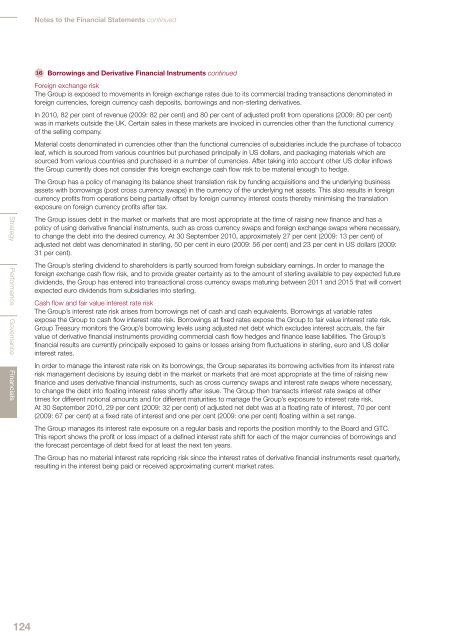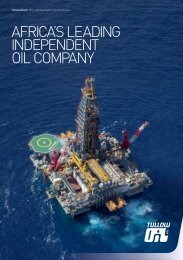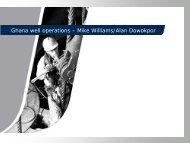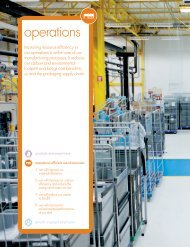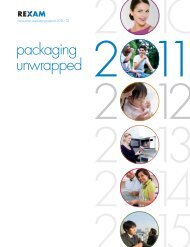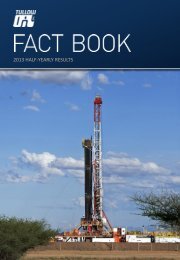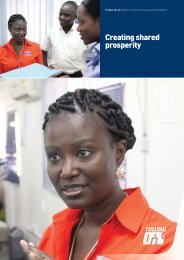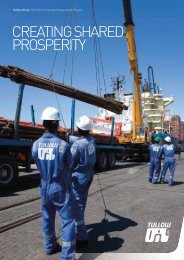Annual report 2010 - Imperial Tobacco Group
Annual report 2010 - Imperial Tobacco Group
Annual report 2010 - Imperial Tobacco Group
You also want an ePaper? Increase the reach of your titles
YUMPU automatically turns print PDFs into web optimized ePapers that Google loves.
Notes to the Financial Statements continued16 Borrowings and Derivative Financial Instruments continuedStrategy Performance Governance FinancialsForeign exchange riskThe <strong>Group</strong> is exposed to movements in foreign exchange rates due to its commercial trading transactions denominated inforeign currencies, foreign currency cash deposits, borrowings and non-sterling derivatives.In <strong>2010</strong>, 82 per cent of revenue (2009: 82 per cent) and 80 per cent of adjusted profit from operations (2009: 80 per cent)was in markets outside the UK. Certain sales in these markets are invoiced in currencies other than the functional currencyof the selling company.Material costs denominated in currencies other than the functional currencies of subsidiaries include the purchase of tobaccoleaf, which is sourced from various countries but purchased principally in US dollars, and packaging materials which aresourced from various countries and purchased in a number of currencies. After taking into account other US dollar inflowsthe <strong>Group</strong> currently does not consider this foreign exchange cash flow risk to be material enough to hedge.The <strong>Group</strong> has a policy of managing its balance sheet translation risk by funding acquisitions and the underlying businessassets with borrowings (post cross currency swaps) in the currency of the underlying net assets. This also results in foreigncurrency profits from operations being partially offset by foreign currency interest costs thereby minimising the translationexposure on foreign currency profits after tax.The <strong>Group</strong> issues debt in the market or markets that are most appropriate at the time of raising new finance and has apolicy of using derivative financial instruments, such as cross currency swaps and foreign exchange swaps where necessary,to change the debt into the desired currency. At 30 September <strong>2010</strong>, approximately 27 per cent (2009: 13 per cent) ofadjusted net debt was denominated in sterling, 50 per cent in euro (2009: 56 per cent) and 23 per cent in US dollars (2009:31 per cent).The <strong>Group</strong>’s sterling dividend to shareholders is partly sourced from foreign subsidiary earnings. In order to manage theforeign exchange cash flow risk, and to provide greater certainty as to the amount of sterling available to pay expected futuredividends, the <strong>Group</strong> has entered into transactional cross currency swaps maturing between 2011 and 2015 that will convertexpected euro dividends from subsidiaries into sterling.Cash flow and fair value interest rate riskThe <strong>Group</strong>’s interest rate risk arises from borrowings net of cash and cash equivalents. Borrowings at variable ratesexpose the <strong>Group</strong> to cash flow interest rate risk. Borrowings at fixed rates expose the <strong>Group</strong> to fair value interest rate risk.<strong>Group</strong> Treasury monitors the <strong>Group</strong>’s borrowing levels using adjusted net debt which excludes interest accruals, the fairvalue of derivative financial instruments providing commercial cash flow hedges and finance lease liabilities. The <strong>Group</strong>’sfinancial results are currently principally exposed to gains or losses arising from fluctuations in sterling, euro and US dollarinterest rates.In order to manage the interest rate risk on its borrowings, the <strong>Group</strong> separates its borrowing activities from its interest raterisk management decisions by issuing debt in the market or markets that are most appropriate at the time of raising newfinance and uses derivative financial instruments, such as cross currency swaps and interest rate swaps where necessary,to change the debt into floating interest rates shortly after issue. The <strong>Group</strong> then transacts interest rate swaps at othertimes for different notional amounts and for different maturities to manage the <strong>Group</strong>’s exposure to interest rate risk.At 30 September <strong>2010</strong>, 29 per cent (2009: 32 per cent) of adjusted net debt was at a floating rate of interest, 70 per cent(2009: 67 per cent) at a fixed rate of interest and one per cent (2009: one per cent) floating within a set range.The <strong>Group</strong> manages its interest rate exposure on a regular basis and <strong>report</strong>s the position monthly to the Board and GTC.This <strong>report</strong> shows the profit or loss impact of a defined interest rate shift for each of the major currencies of borrowings andthe forecast percentage of debt fixed for at least the next ten years.The <strong>Group</strong> has no material interest rate repricing risk since the interest rates of derivative financial instruments reset quarterly,resulting in the interest being paid or received approximating current market rates.124


